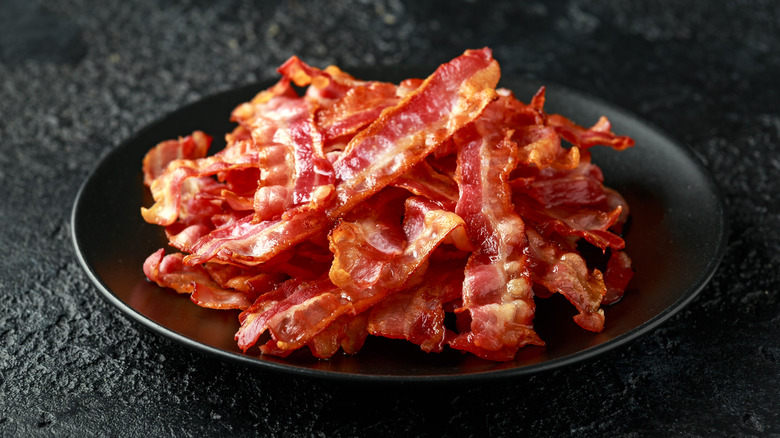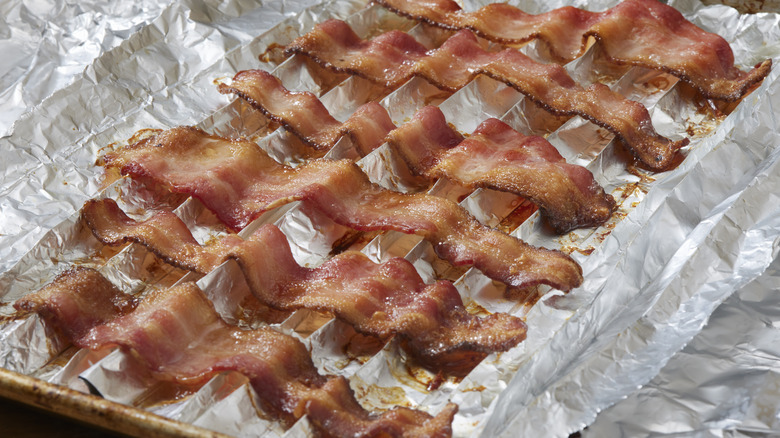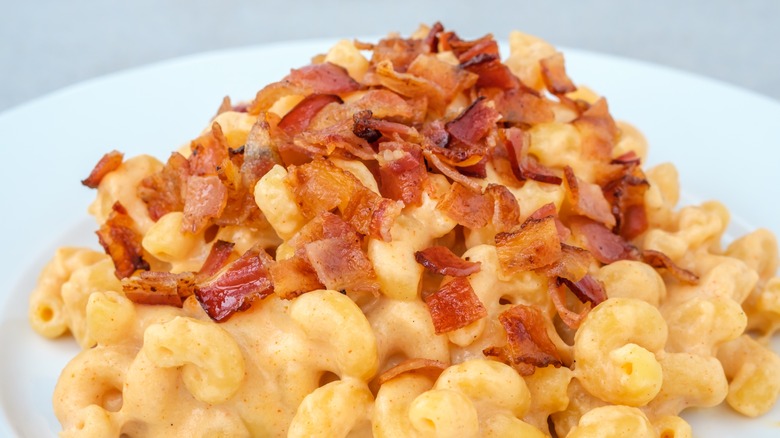For The Crispiest Oven-Baked Bacon, Cook The Strips On Aluminum Foil
When it comes to idolized ingredients, bacon stands alone. The cured pork product has amassed legions of followers who are prepared to eat it in any form offered to them — no matter how daring or bizarre. Online, you can find recipes for everything from bacon-stuffed brownies to bacon butter to chocolate peanut bacon milkshakes.
But in reality, bacon is totally tasty without all the bells and whistles. A few slices of perfectly brittle bacon next to some scrambled eggs, toast, and home fries remains the quintessential American breakfast. Yet while it remains a humble and accessible culinary luxury, how to cook bacon is riddled with debate. Ask anyone how they make their bacon and you're sure to receive a mishmash of responses. From preparing the strips in a cast iron skillet to microwaving to air-frying, the conversation over which technique is best rages on.
Still, it's hard to deny that some methods have certain advantages over others. Bacon is notoriously fatty and releases a thick puddle of grease after cooking that can cause issues in your kitchen if not disposed of correctly. So how does one achieve a slice of bacon that's magnificently crisp texture and easy to clean up after? Line your baking sheet with aluminum foil before cooking.
Use aluminum foil to achieve mess-free bacon
Cooking bacon in the oven is not a new idea. Many prefer this method to the frying pan because it reduces the risk of a grease splatter, doesn't require constant attention, and can make a greater quantity at one time. That being said, there's not just one way to bake your bacon, with factors like time, temperature, type of baking sheet as well as the material (if any) used to line it.
An aluminum lining stands above the rest for a few reasons. First, it results in evenly cooked bacon that's crunchy front to back. Essentially, the strips fry in their own grease, creating a crisp texture, especially along the sections striped with fat. Compare this method to using a bare sheet pan, where you're likely to get bacon that's cooked unevenly on one side.
Another advantage of aluminum foil is the ease of cleanup. After your bacon is cooked, you can literally just pick up the aluminum and drain off the remaining fat into a jar or other waste receptacle of your choice. Just remember when you're lining your sheet pan to use enough aluminum foil so that it hangs over the sides, otherwise, some of the grease might leak out.
Inventive ways to use your crispy bacon
Bacon is one of the most dynamic ingredients around, playing nicely with both sweet and savory flavors. Its deep saltiness and porky undertones enhance everything from dark chocolate to popcorn to guacamole, which is why bacon has a place in any meal of the day. Bacon is indeed synonymous with breakfast, but that doesn't mean you have to limit yourself to fried eggs and home fries.
Try adding crumbled bacon to cheesy grits, where its crunch and smokiness offsets the mushy cornmeal, or sprinkle some on your next bowl of cooked oatmeal and drizzle with maple syrup for an unconventional breakfast mashup. For lunch, bacon can serve as the crisp, porky relief to anything from salads to sandwiches to bowls of macaroni and cheese. It goes great on an apple brie sandwich or slipped into a classic PB&J.
When it comes to dinner you have plenty of options. Bacon meatballs, bacon-crab dip, bacon-braised cabbage, bacon jalapeño corn chowder, or bacon-stuffed chicken breast are all fair game. And for dessert, well, buckle in those tastebuds. Try variations on the classics, like pumpkin maple-bacon cheesecake or bourbon-soaked bacon cinnamon rolls. And if you're really adventurous, may as well just go with this over-the-top bacon caramel apple pie.
But at the end of the day, the beautiful thing about perfectly crispy bacon baked on tin foil is that it's also delectable all on its own.


